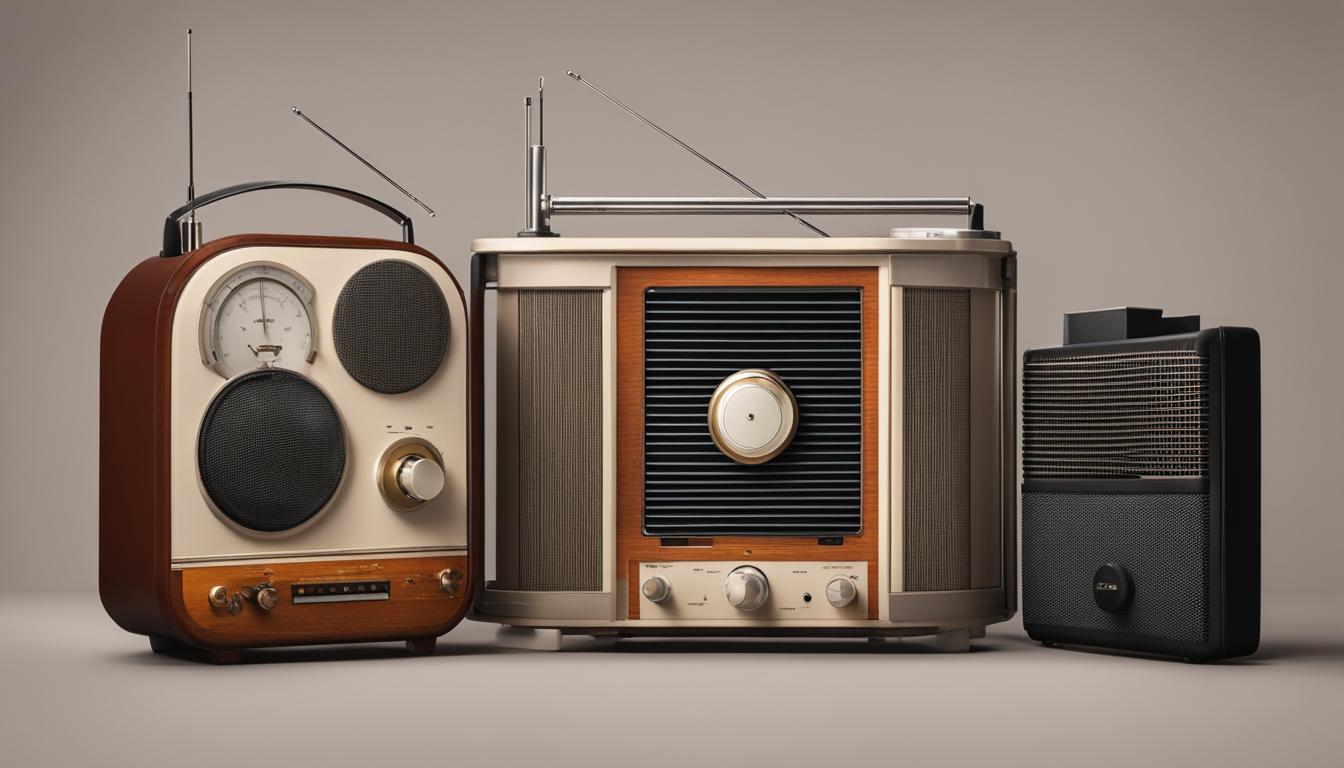Podcasts and traditional radio shows may seem similar at first glance, but they have distinct differences in terms of content structure, consumption, audience variations, editing, and moderation. Understanding these differences can help you navigate the world of audio entertainment and choose the format that suits your preferences.
Key Takeaways:
- Podcasts and traditional radio shows have differences in content structure, consumption, audience variations, editing, and moderation.
- Podcasts are usually episodic, focusing on one subject per episode, while radio shows cover various topics in long durations.
- Podcasts are actively sought out by listeners, while radio shows are often listened to passively.
- Podcasts offer more portability as they can be downloaded and listened to on smartphones.
- Radio shows are often live and unedited, while podcasts are preplanned and edited for a polished end product.
Content Structure and Format
When comparing podcasts and traditional radio shows, one of the key differences lies in their content structure and format.
Radio shows are typically hours long and cover a wide range of topics within each episode. They often include segments such as news updates, interviews, music, and entertainment. The goal is to cater to a broad audience and provide a diverse listening experience. In contrast, podcasts are usually episodic and focus on a specific subject or theme in each episode. This allows for a more in-depth exploration of the topic, offering a niche audience an opportunity to delve deeper into their areas of interest.
Another notable difference is the repetition of information in radio shows. As radio shows are broadcasted live and cater to a larger audience, they often repeat important information to ensure that late listeners are up to date. On the other hand, podcasts assume that the listener starts from the beginning and therefore do not repeat information. This makes podcasts more streamlined and efficient for dedicated listeners who follow each episode.
In terms of music, radio shows tend to incorporate more music into their content. This is partly due to licensing restrictions that make it challenging for podcasts to feature copyrighted music. Podcasts, instead, rely more heavily on spoken content, interviews, and discussions. This creates a different atmosphere compared to radio shows, which often include music as part of their regular programming.
| Radio Shows | Podcasts | |
|---|---|---|
| Content Structure | Hours long, covering various topics within each episode | Episodic, focusing on one subject or theme per episode |
| Repeating Information | Repeats important information for late listeners | Assumes the listener starts from the beginning, no repetition |
| Playing of Music | More music due to licensing and regular programming | Less music due to licensing restrictions |
The content structure and format of podcasts and traditional radio shows offer distinct advantages and cater to different preferences and listening habits.
Consumption and Accessibility
When it comes to consuming audio content, there are distinct differences between radio and podcasts. Radio shows are often listened to passively while doing other tasks, such as driving or working, whereas podcasts require active selection and engagement. Listeners actively seek out podcasts based on their interests and preferences, making them a more intentional form of audio consumption.
One of the advantages of podcasts is their portability. Unlike radio shows that are limited to live broadcasts or scheduled air times, podcasts can be downloaded and listened to at any time. This flexibility allows listeners to enjoy their favorite podcasts while commuting, exercising, or doing household chores. The portability of podcasts adds convenience to the overall listening experience.
Despite the rise in popularity of podcasts, radio remains a widely accessible medium. Radio shows can be accessed through traditional FM/AM frequencies, as well as online streaming platforms. Furthermore, radio has a nostalgic appeal and familiarity for many listeners. It continues to cater to a diverse audience, including those who may not be as tech-savvy or have access to reliable internet connections.
Audience Variations in Radio and Podcasts
It’s important to note that different generations have varying preferences when it comes to audio consumption. Millennials, for example, are more inclined towards podcasts due to their on-demand nature and the ability to tailor content to specific interests. They appreciate the freedom of choice and the wide variety of subjects covered in podcasts. On the other hand, older generations, such as Gen X listeners, still lean towards radio shows, valuing the familiar format and the sense of community that comes from tuning in to live broadcasts.

| Radio | Podcasts | |
|---|---|---|
| Listening Style | Passive | Active |
| Portability | Less portable due to live broadcasts | Highly portable with the ability to download episodes |
| Accessibility | Widely accessible through traditional radio frequencies | Accessible with an internet connection |
| Audience Preferences | Appeals to a diverse audience, particularly older generations | Popular among younger generations, especially millennials |
In summary, while radio shows offer passive listening and wide accessibility, podcasts provide a more active and personalized experience. The portability of podcasts makes them suitable for the on-the-go lifestyle of many listeners. Additionally, different generations gravitate towards different audio mediums, with millennials embracing podcasts and older listeners sticking to traditional radio. Understanding these audience variations is crucial for content creators and advertisers looking to reach their target demographics effectively.
Editing and Interaction
Radio shows and podcasts differ in their approach to editing and audience interaction. The live nature of radio shows often means that they are unedited and spontaneous. This allows for real-time audience participation through phone calls, messages, and live interviews. The interactive nature of radio shows creates a sense of immediate connection between the host and the listeners.
In contrast, podcasts take a more preplanned and edited approach. The content of each episode is carefully crafted and edited for a polished final product. This allows podcast hosts to present information in a structured and organized manner. While audience interaction is not as immediate as in live radio shows, podcasts often encourage listener engagement through comments, social media interactions, and email feedback.
The different editing styles of radio shows and podcasts contribute to variations in trust and perception. Radio shows, with their live and unedited format, are often seen as more trustworthy due to the regulations they adhere to. On the other hand, the lack of regulations in podcasts can make them appear more egalitarian and authentic. Listeners may perceive podcasts as a platform where more diverse voices are heard and unfiltered opinions are shared.
The Role of Trust in Radio and Podcasts
Trust plays a crucial role in the success and popularity of both radio shows and podcasts. Radio shows have a long-standing history, and listeners have developed a sense of trust in their reliability and accuracy. The professionalism and accountability associated with radio broadcasting contribute to this trust.
Podcasts, although newer to the scene, also rely on trust to attract and retain listeners. While podcasts may not have the same level of regulation as radio shows, building trust is often achieved through the host’s credibility, expertise, and authenticity. The open and personal nature of podcasts allows hosts to establish connections with their audience, creating an environment where trust can thrive.
Overall, both radio shows and podcasts offer unique opportunities for editing, interaction, and trust-building. While radio shows thrive on live and unedited content with real-time audience interaction, podcasts provide a preplanned and edited format with opportunities for audience engagement through comments and social media. The different approaches to editing and interaction contribute to the distinct experiences that radio and podcast listeners seek.
Conclusion
When it comes to advertising, podcasts offer several distinct advantages over traditional radio ads. Podcast advertising allows for better targeting and audience insights, providing advertisers with the opportunity to reach niche audiences more effectively. The flexibility and engagement of podcast ads are also noteworthy, with interactive features that encourage listener interaction and participation.
One of the key benefits of podcast ads is the personalization they offer. Advertisers can tailor their messages to the specific interests and preferences of their target audience, resulting in a more relevant and engaging listening experience. Additionally, podcast ads provide convenience to listeners, as they can be seamlessly integrated into the content and don’t disrupt the overall flow of the episode.
The future of advertising seems to be leaning towards podcasts, as they continue to rise in popularity and effectiveness. With the ability to deliver targeted, personalized, and convenient advertising experiences, podcast advertising is becoming an attractive option for both advertisers and listeners. As the podcasting industry evolves, we can expect to see even more innovative ad formats and strategies that further enhance the effectiveness and impact of podcast ads.
FAQ
How do podcasts differ from traditional radio shows?
Podcasts and traditional radio shows have distinct differences in terms of content structure, consumption, audience variations, editing, and moderation.
What are the differences in content structure and format?
Radio shows are often hours long and cover various topics, while podcasts are usually episodic and focus on one subject per episode. Radio shows tend to repeat information for late listeners, whereas podcasts assume the listener starts from the beginning. Podcasts include less music due to licensing restrictions, while radio shows often feature current news and time-focused content.
How does consumption and accessibility vary?
Radio is often listened to passively while doing other tasks, while podcasts are actively sought out and can be listened to at any time. Podcasts offer more portability as they can be downloaded and listened to on smartphones. Despite the growth of podcasts, radio remains more popular due to its wide accessibility and the nostalgia factor. Different generations prefer different audio mediums, with millennials leaning towards podcasts and gen X listeners favoring radio.
What are the differences in editing and interaction?
Live radio shows have a more unedited and spontaneous nature, allowing for real-time audience interaction. Podcasts, on the other hand, are preplanned and edited for a polished end product. Radio is generally seen as more trustworthy due to regulations, while the lack of regulations in podcasts can make them appear more egalitarian. Both radio and podcasts have opportunities for crossovers and extensions to other formats.
How do podcast advertising and radio ads compare?
Podcast advertising offers more targeted and personalized options compared to radio ads. Podcasts allow for better targeting and engagement, with interactive features and audience insights. Podcast ads can reach niche audiences and provide a more natural and relevant listening experience. The future of podcasts vs. radio shows a shift towards the popularity and effectiveness of podcast advertising.
 Skip to main content
Skip to main content


